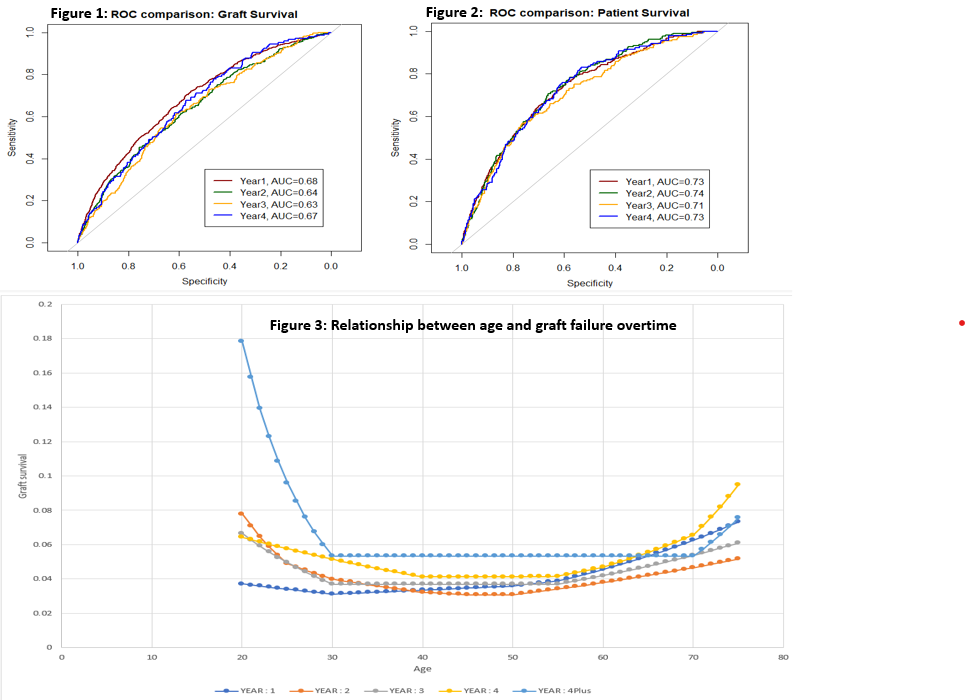Predicting Post-transplant Death and Graft Loss Risk: Insight at Listing
1CareDx, Brisbane, CA, 2Saint Louis University, St. Louis, MO
Meeting: 2021 American Transplant Congress
Abstract number: 109
Keywords: Age factors, Graft function, Mortality, Survival
Topic: Clinical Science » Public Policy » Non-Organ Specific: Public Policy & Allocation
Session Information
Session Name: Potpourri of Public Policy and Allocation
Session Type: Rapid Fire Oral Abstract
Date: Sunday, June 6, 2021
Session Time: 4:30pm-5:30pm
 Presentation Time: 5:00pm-5:05pm
Presentation Time: 5:00pm-5:05pm
Location: Virtual
*Purpose: Prognostication models for post-transplant outcomes deriving inputs from information collected on donor (DDR/LDR), candidate (TCR) and transplant recipient (TRR) registrations can provide useful information to guide risk assessment and management. Our novel machine learning approach assesses patients at listing and different points during pre-transplant phase to predict post-transplant graft and patient survival.
*Methods: Organ Procurement and Transplant (OPTN) registry data for 97,963 adult kidney-only transplant recipients (2009-2019) was used to estimate 1-, 2-, 3-, and 4-year post-transplant graft (GS) and patient survival (PS). Pediatric and multi-organ transplants were excluded. Follow-up was censored at the end of study (09/08/2019). Cox models were built using LASSO regularization and shrinkage with 10-fold cross-validation. Features included listing data, co-morbidities and functional status. Waiting time was accounted for utilizing earliest of dialysis or listing dates for the listing record. To account for effect-size of covariates across time, GS and PS estimates were derived for each post-transplant year independently. For improved accuracy, variance inflation factor was used to detect multicollinearity and assign predictor weights appropriately.
*Results: AUCs for 1-, 2-, 3-, and 4-year post-transplant GS were 0.68, 0.64, 0.63 and 0.67 (Figure 1), respectively. AUCs for 1-, 2-, 3-, and 4-year post-transplant PS were 0.73, 0.74, 0.71 and 0.73, respectively (Figure 2). We observed a change in relationship between age and graft survival over time (Figure 3). Risk of graft failure increased linearly with age during year 1 but was more pronounced for younger and older patients over in later years. Finally, outcomes for each post-transplant year were estimated for representative donor groups (living donor and KDPI categories) for the purpose of providing augmented intelligence for clinical practices.
*Conclusions: Assessment of post-transplant outcomes using patient information collected at the time of listing demonstrated utility to assess post-transplant risk for patients on the waiting list. Machine learning models could be translated into decision support tools to standardize and optimize waitlist management.
To cite this abstract in AMA style:
Dzebisashvili N, Schnitzler M, Lentine K, Venkataramani K, Ghosh S. Predicting Post-transplant Death and Graft Loss Risk: Insight at Listing [abstract]. Am J Transplant. 2021; 21 (suppl 3). https://atcmeetingabstracts.com/abstract/predicting-post-transplant-death-and-graft-loss-risk-insight-at-listing/. Accessed July 18, 2025.« Back to 2021 American Transplant Congress

